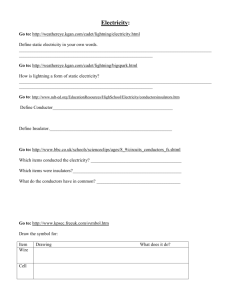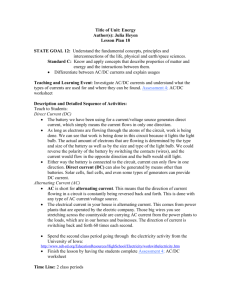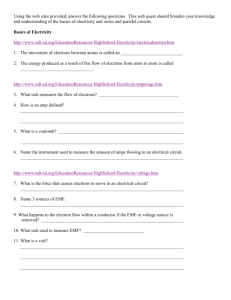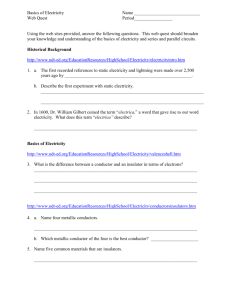Basics of Electricity Web Quest Name: Using the web sites provided
advertisement
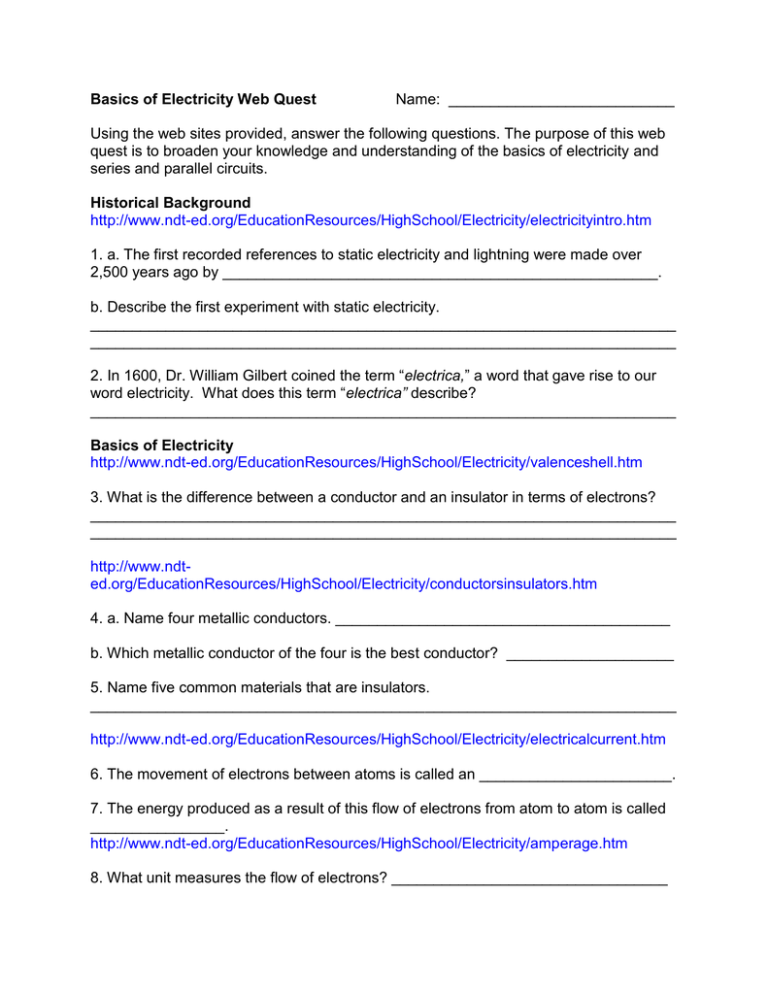
Basics of Electricity Web Quest Name: ___________________________ Using the web sites provided, answer the following questions. The purpose of this web quest is to broaden your knowledge and understanding of the basics of electricity and series and parallel circuits. Historical Background http://www.ndt-ed.org/EducationResources/HighSchool/Electricity/electricityintro.htm 1. a. The first recorded references to static electricity and lightning were made over 2,500 years ago by ____________________________________________________. b. Describe the first experiment with static electricity. ______________________________________________________________________ ______________________________________________________________________ 2. In 1600, Dr. William Gilbert coined the term “electrica,” a word that gave rise to our word electricity. What does this term “electrica” describe? ______________________________________________________________________ Basics of Electricity http://www.ndt-ed.org/EducationResources/HighSchool/Electricity/valenceshell.htm 3. What is the difference between a conductor and an insulator in terms of electrons? ______________________________________________________________________ ______________________________________________________________________ http://www.ndted.org/EducationResources/HighSchool/Electricity/conductorsinsulators.htm 4. a. Name four metallic conductors. ________________________________________ b. Which metallic conductor of the four is the best conductor? ____________________ 5. Name five common materials that are insulators. ______________________________________________________________________ http://www.ndt-ed.org/EducationResources/HighSchool/Electricity/electricalcurrent.htm 6. The movement of electrons between atoms is called an _______________________. 7. The energy produced as a result of this flow of electrons from atom to atom is called ________________. http://www.ndt-ed.org/EducationResources/HighSchool/Electricity/amperage.htm 8. What unit measures the flow of electrons? _________________________________ 9. How is an amp defined? ______________________________________________________________________ ______________________________________________________________________ 10. Name the instrument used to measure the amount of amps flowing in an electrical circuit. _______________________________________________________________ http://www.ndt-ed.org/EducationResources/HighSchool/Electricity/voltage.htm 11. What is the force that causes electrons to move in an electrical circuit? ______________________________________________________________________ 12. Name 3 sources of EMF. ______________________________________________ 13. What happens to the electron flow within a conductor if the EMF or voltage source is removed? _____________________________________________________________ 14. What unit used to measure EMF? ___________________________ http://www.ndt-ed.org/EducationResources/HighSchool/Electricity/resistance.htm 15. What is resistance? ______________________________________________________________________ ______________________________________________________________________ 16. In what units is resistance measured? ____________________________________ 17. State one example when resistance is desirable. ______________________________________________________________________ ______________________________________________________________________ 18. State one example when resistance is undesirable. ______________________________________________________________________ ______________________________________________________________________ 19. What components are placed in an electrical circuit to control the amount of resistance in circuit? ____________________________________________________ http://www.ndt-ed.org/EducationResources/HighSchool/Electricity/ohmslaw.htm 20. In 1827, George Ohm developed a mathematical relationship between voltage, current, and resistance called ___________________________________________. 21. a. State Ohm’s Law in a mathematical equation. ____________________________ b. What do the following variables represent? I = ____________________________ V = ____________________________ R = ___________________________ 22. Using the equation, I = V / R, describe the following: a. If the voltage is increased what will happen to the current? ____________________ b. If the resistance is increased what will happen to the current? __________________ 23. Using the second equation, V = I • R, describe the following: a. If either the current or the resistance is increased in the circuit, what will happen to the voltage? __________________________ 24. Using the third equation, R = V / I, describe the following: a. If the voltage is increased what will happen to the resistance? __________________ b. If the current is increased what will happen to the resistance? __________________ 25. What is the symbol of an ohm? ___________________ http://www.ndt-ed.org/EducationResources/HighSchool/Electricity/circuitdiagrams.htm Below is a circuit diagram, list what each part of the diagram represents (the “V”, “A”, “squiggly lines” and the two components on the right hand side). Place answers in the spaces below. 26. = __________________ 27. = _____________________ 28. = __________________ 29. = ______________________ 30. = __________________ http://www.ndt-ed.org/EducationResources/HighSchool/Electricity/seriescircuit.htm 31. Build the series circuit at this web site. 32. Describe a series circuit. ______________________________________________________________________ ______________________________________________________________________ 33. What is a load in a circuit? ______________________________________________________________________ ______________________________________________________________________ 34. What is a short circuit? ______________________________________________________________________ ______________________________________________________________________ ______________________________________________________________________ 35. What is used in an electrical circuit to prevent a short circuit? ______________________________________________________________________ 36. Build the series circuit with resistors at this web site. http://www.ndt-ed.org/EducationResources/HighSchool/Electricity/parallelcircuit.htm 37. Build the parallel circuit at this web site. 38. Describe a parallel circuit. ______________________________________________________________________ ______________________________________________________________________ 39. Build the parallel circuit with a voltmeter at this web site. 40. How is the ammeter always placed in a circuit? ____________________________ 41. How is the voltmeter always placed in a circuit? ____________________________ http://www.ndt-ed.org/EducationResources/HighSchool/Electricity/seriesparallel.htm 42. Build the series / parallel circuit at this web site. 43. List the components that are connected in series from the circuit you just constructed. ______________________________________________________________________ ______________________________________________________________________ ______________________________________________________________________ 44. List the components that are in parallel from the circuit you just constructed. ______________________________________________________________________ ______________________________________________________________________
